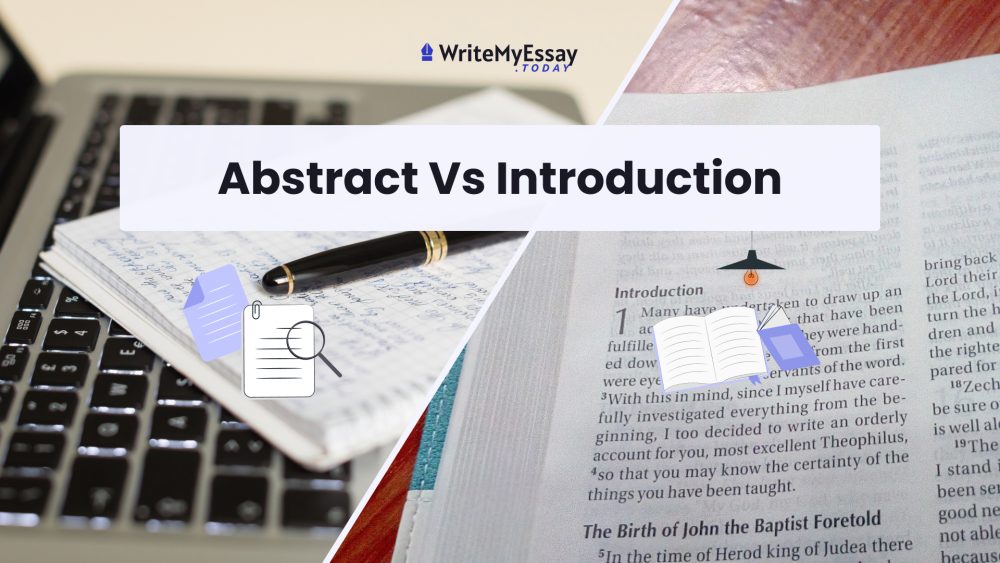One of the most confusing aspects of writing a research paper for a first-timer is knowing how to draft the starting. It’s not surprising because most people think that abstract and introduction mean the same thing. So, a popular Google search among newbie researchers would be “what’s the difference between abstract and introduction?“ So, what is the content structure for abstract or introduction sections?
Are they different? If they are different, which should come first? If you don’t want to bother with any of these questions, you can always seek professional help by asking experts, “Please write my research paper by the date I give you.”
But if you’d like to understand everything on your own, let’s look intently into all the differences and possible similarities between intro and abstracts in this article. Please note that not all papers will need both an abstract and an introduction.
You may find abstract and introduction examples in a variety of write-ups. But while abstract is found in research papers, thesis and dissertations, the introduction is located in a broader range of write-ups. Understanding their differences will help you know if and when to use either.
What is the difference between abstract and introduction?
The simple explanation is that the abstract provides a concise summary of your paper while the introduction offers detailed background information on your research. Now let’s delve into a more detailed explanation of the difference between introduction and abstract.
What is an abstract in research?
Abstracts, like academic services, are all about simplicity. Think about it. Students who don’t want to do their homework get in touch with professional companies, and just saying, “Write my essay for me” is enough to get the results they want.
Similarly, it’s enough to read an abstract to understand what the entire text is about. An abstract is one of the foremost portions of your research paper that aims to get the reader’s attention by giving a succinct description of the paper. It summarizes the paper in a couple of paragraphs. It also explains its results. If you want to get the juice of the paper without needing to skim through it, read the abstract.
Format of an abstract
Writing an abstract may come in both structured and unstructured formats. A structured format breaks the important information into bullet points, an easy-to-read format for the reader. It has sections and headings as follows:
- Background: this will set the tone for the paper. In the background, you will give the latest information on the topic, the gap in knowledge, and some relevant phrases that will arouse the reader’s interest.
- Objectives/Aims: what does the study intend to achieve, and what are its aims and objectives. What does the paper examine? What are the research questions you proposed?
- Methods: this is where you discuss the materials used and the study’s design. You’d also describe what you investigated in the course of the research.
- Results: what are your key findings and observations?
- Conclusion: The conclusion explains the why of your results. Were the results expected? Would more research be required on the topic or not?
An unstructured abstract does not include bullet point headings. The text would, however, be a long paragraph that contains the points listed in the structured format.
What is an introduction in research?
The introduction is the first main section of your study after your abstract. It provides more in-depth information about the background information of the research and what you attempt to discover. It discusses briefly the current knowledge that exists in the field and why your study is new and relevant in the field.
Format of an introduction
Make your introduction as brief and concise as possible. You can take the reader through four well-structured paragraphs that are not more than one page. You may use this format for the four paragraphs.
- First paragraph: introduce the context of the research study. Give background information on the study.
- Second paragraph: explain the research gap by describing what is currently known in the field by previously published researchers.
- Third paragraph: explain why the study is needed. How your research is essential to fill the gap.
- Fourth paragraph: explain in clear terms the aims, objectives and hypothesis of your study.
Abstract vs introduction
So, are abstract and introduction the same? This section shows, at a glance, the main differences between abstract and introduction.
| Abstract | Introduction |
| Clear summary of the research with methods, results and conclusion. | Introduces the research with background information. |
| Contains results, conclusions and recommendations | Does not contain results, conclusions and recommendations |
| The Abstract can stand alone and make sense without reading the body of the research. | The introduction cannot make sense without the main text. |
| Found in research papers, thesis and dissertations. | Can be found in a wide variety of texts and write ups. |
Conclusion
With the foregoing, discussing introduction vs abstract should be clearer now. The abstract is an essential aspect of a research paper because it explains what you have in your paper in a few paragraphs. This is useful for anyone who might want to reach the heart of your paper without having to read the whole thing.
On the other hand, the introduction discusses the issue you want to resolve in your paper and how important it is to your field of study. Now, you can order essay along with an abstract or start implementing the ideas you’ve seen in this article. Just keep everything you’ve learned in mind, and you’re good to go.



